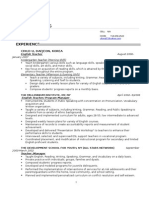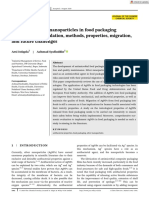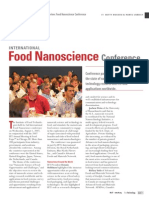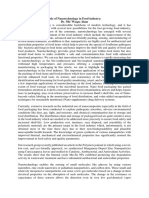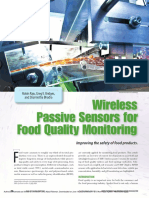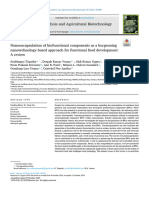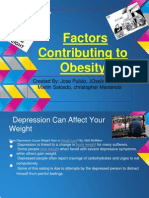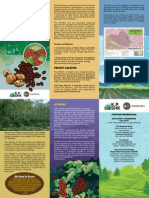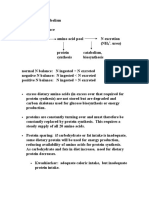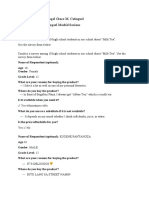Professional Documents
Culture Documents
Advancing Food Industry With Quantum Dot Technology
Advancing Food Industry With Quantum Dot Technology
Original Title
Copyright
Available Formats
Share this document
Did you find this document useful?
Is this content inappropriate?
Report this DocumentCopyright:
Available Formats
Advancing Food Industry With Quantum Dot Technology
Advancing Food Industry With Quantum Dot Technology
Copyright:
Available Formats
Volume 9, Issue 4, April – 2024 International Journal of Innovative Science and Research Technology
ISSN No:-2456-2165 https://doi.org/10.38124/ijisrt/IJISRT24APR684
Advancing Food Industry with
Quantum Dot Technology
Sunanda Mondal1* Vimal Pant2
M. Tech Scholar, Food Plant Operations Management, Head Of Department of Food Business Management and
National Institute of Food Technology Entrepreneurship Development, National Institute of Food
Entrepreneurship and Management, Technology Entrepreneurship and Management,
Sonipat, India Sonipat, India
Sayantani Mondal3
PhD Scholar, Dairy Technology Division,
National Dairy Research Institute, Karnal
Corresponding Author: Sunanda Mondal1*
Abstract:- Since people consume different varieties of I. INTRODUCTION
food, they are more conscious of their health nowadays.
Food analysis, which is a major element, helps to Among people, awareness to concentrate on health has
monitor the food quality for risk assessment regarding been increasing in recent years owing to their superior
public health. As Carbon Quantum Dots (CQDs) are the development in living standards. In general, the basic need
least toxic, they are in great demand. They help to in life is food. One of the basic human rights is food safety,
optimize food packaging, detect as well as monitor and supplying it helps to optimize human health, which
foodborne pathogens, and assess food quality utilizing enhances the length and quality of people’s lives [1]. But,
imaging and sensing. Owing to their nontoxicity and eco- the most challenging things among food safety problems are
friendliness, CQDs stand unique although there are antibiotics (contaminants) and pesticides (contaminants) [2].
different kinds of Quantum Dots (QDs). To enhance food Nanotechnology plays a significant role in increasing food
safety, quality assessment, and packaging, CQDs also security and safety although various conventional techniques
deliver exciting possibilities. CQD applications can have exhibited accurate outcomes for food detection. Some
detect insecticide residues, antibiotics, nutrients, heavy of the energy-efficient nanomaterials, which are developed
metals, pathogens, and food additives. Furthermore, to note down the variation in the quality of packaged foods,
CQDs find use in food packaging materials in which are carbon-based materials and metallic nanoparticles. But,
their Ultraviolet (UV) barrier, antimicrobial, and distinct fluorescent nanomaterials like QDs, which are made
antioxidant properties increase product shelf life and of inorganic material or heavy metal, are semiconductor
decrease food waste. Hence, explaining CQDs’ industrial nano-sized particles. In the food sector, CQDs have an
applications in the food sector is the study’s objective. In exceptional place among various types of QDs owing to
this paper, CQDs' role in food processing and its their distinct properties and applications [3]. CQDs are
industrial applications in food sectors, including food quasi-spherical particles that are less than 10 nm in size with
detection and packaging are explored. significant physicochemical features, such as high
photostability, low toxicity, chemical inertness, inexpensive,
Keywords: Quantum Dots, Carbon Quantum Dots, Food and biocompatibility [4]. CQDs possess various
Sector, Heavy Metals, Pathogens And Contaminants. applications, namely food packaging and food detection in
the food industry [5]. Different types of sources used in the
carbon dots fabrication for active food packaging
applications are explained in Figure 1.
IJISRT24APR684 www.ijisrt.com 422
Volume 9, Issue 4, April – 2024 International Journal of Innovative Science and Research Technology
ISSN No:-2456-2165 https://doi.org/10.38124/ijisrt/IJISRT24APR684
Fig 1: Different Sources Utilized for the Fabrication of CQDs for Active Food Packaging Applications
In the food industry, CQDs have important internal What are the related studies of CQDs in food detection?
applications, particularly in the scope of food packaging,
food safety, and food detection. To increase product shelf III. LITERATURE REVIEW ON INDUSTRIAL
life as well as safety, CQDs are merged into the respective APPLICATION OF CARBON QUANTUM
materials in the food packaging area. CQDs can identify DOTS IN THE FOOD SECTOR
heavy metals [6] and pathogens [7] and help to monitor
antibiotic residues in the food detection area. Moreover, For diagnosis of residual toxicants in agricultural,
CQDs have different properties that make them more fit for environmental, and food samples, CQDs are found to be fit
food safety. since they examined their normal operation, higher
sensitivity, large surface area, and nanoscale size.
After the introduction (“Section 1”), the paper’s
structure is arranged as: “Section 2” presents the research Thus, this review paper is created to contribute to the
questions to make the review more clear. The literature CQDs' role in food processing as well as CQDs’ industrial
survey for CQDs’ industrial application in the food sector is applications in the food sector, including food packaging
explained in “Section 3”. “Section 4” describes the and food detection.
summary of the study to know the outcomes attained via the
study. Lastly, “Section 5” ends the survey with suggestions A. CQDS’ Role in the Food Processing
and future recommendations. Similar to the ‘farm-to-table’ strategy, CQDs should
monitor as well as take care of food production quality at all
II. RESEARCH QUESTIONS stages [8]. Moreover, CQDs are generally named carbon
nanodots. They are more efficient in guaranteeing food
In a systematic review, a Research Question (RQ) is safety. In addition, CQDs can identify insecticide residues,
essential. Before entering into the research, designing a heavy metals, pathogens, and food additives [9].
well-structured research question is important. To make the
review paper more creative, the following questions must be Fatemeh, et al. [10] described the Fluorescent turn-on
answered. sensing of Caffeine in food samples based on Sulfur-doped
CQDs (S-CQDs) through the Response Surface
What is the role of CQDs in food processing? Methodology. S-CQDs were integrated using the
What are CQDs’ industrial applications in the food microwave-assisted treatment. The outcomes indicated that
sector? with caffeine’s enhancing concentrations from 0.2 μM to 70
What is CQDs’ importance in the food packaging μM, the model’s fluorescence intensity enhanced.
application?
IJISRT24APR684 www.ijisrt.com 423
Volume 9, Issue 4, April – 2024 International Journal of Innovative Science and Research Technology
ISSN No:-2456-2165 https://doi.org/10.38124/ijisrt/IJISRT24APR684
Achilleas, et al. [11] analyzed the N/S-CQDs’ growth the growth of edible coatings along with packages, CQDs
as well as characterization by validating Greek Crayfish were used together with their use in the pharmaceutical and
Food Waste. Instrumental and chemical techniques were healthcare applications and the food industry.
utilized to characterize the final product. As per the analysis,
Nitrogen co-doped CQDs (N/S-CQDs) provided superior Zifan, et al. [14] explained the Nitrogen-doped CQDs
outcomes since the coated strawberries sustained their color (N-CQDs) with the synthesis by utilizing the solvothermal
as well as weight for 3 successive days. approach. N-CQDs were used to detect the trace of Ag+ in
food packaging material. Analysis indicated that Ag+ was
Jungbin, et al. [12] explained the food waste-driven N- robustly and correctly detected by N-CQDs, which were
doped carbon dots with cell imaging as well as Fe3+ sensing found to be a promising tool for the detection of Ag+ traces
applications. For analyzing CQDs’ chemical transition, food in food packaging materials.
waste-driven cat feedstocks were used. Outcomes indicated
that similar to the waste model having 28% quantum yield, Yuqing, et al. [15] established the edible antibacterial
food waste-driven CQDs had the same chemical as well as film preparation based on Corn Starch /Carbon Nanodots
fluorescent properties. (CS-CNDs) for bioactive food packaging. Analyzing the
CS’s antimicrobial, antioxidant, and physical properties
B. Industrial Application of CQDS in Food Sector regarding CQDs is the objective. The outcomes displayed
Enhancing food sustainability, quality, and safety is the that in developing accessible films for packaging food items,
purpose of investigating CQDs’ industrial applications in the adding low concentrations of CQDs with CS indicated
food sector. Some of the important CQD applications in the evident outcomes.
food sector are food packaging and food detection.
Food Detection
Food Packaging CQDs, which could be used to detect food ingredients
In food packaging, CQDs have the most significant and contaminants, are a type of photoluminescent
role as well as possess a wide range of potential nanomaterial [16]. Furthermore, CQDs could be utilized for
applications. For preserving the freshness and quality as detecting food additives, pathogens, heavy metals,
well as increasing the shelf-life of the food, CQDs help in Insecticide and antibiotic residues, as well as Nutritional
creating new biodegradable anti-oxidation, antibacterial, and components [17]. In the pathogens’ detection, carbon dots-
biocompatible films for food packaging. centric biosensors are chosen owing to their higher
sensitivity and selectivity in the food sector [18]. Detection
Melis, et al. [13] described the CQDs as Edible Food Limit (DL), Limit Of Quantification (LOQ), and Relative
Packaging Films and Coatings with antimicrobial as well as Standard Deviation (RSD) are the parameters used in the
UV-blocking properties. From the location of Sigma- findings. Table 1 illustrates some of the CQD research
Aldrich, the material named Polyethylene Glycol (PEG) as papers in food detection with its specimens, samples, and
well as urea were gathered. According to the findings, for outcomes.
Table 1: Studies of CQDs in Food Detection with Specimens, Samples and Outcomes
Author Specimen Aim Food Findings
Name Samples DL RSD
Chunhao, et Not mentioned To identify residues from leafy Leafy vegetables 0.00187 mg/kg 0.001 and
al. [19] vegetables using CQDs 0.027%
Xuetao, et Melamine Identifying melamine in milk on Milk 0.0036 μm (3.6 nM) LOQ
al. [20] the basis of gold doped CQDs 12 nM
Yuanyuan, Tetracycline To identify Tetracycline in Natural red beet 0.36 μm Not mentioned
et al. [21] foods on the basis
of CQDs
Ziting, et al. Tetracycline Identifying Tetracycline in foods Milk and pork 0.25 μm Not mentioned
[22] on the basis of Cerium-doped
CQDs
Wenting, et 4-nitrophenol To identify 4-nitrophenol in foods Fish 23.45 nmol⋅L1 RSD
al. [23] on the basis of Silane- Lower than 5%
functionalized CQDs
Guangxin, et al. [24] explained the Ratiometric Chunling, et al. [25] described CQDs established from
Fluorescence Immunoassay based on CQDs to diagnose chicken blood as peroxidase mimics for biothiols’
Malachite Green in Fish. Horseradish peroxidase was used colorimetric detection. The traditional colorimetric method
to transform o-phenylenediamine to 2, 3-diaminophenazine. was utilized for identifying biothiols using CQDs. The
As per the analysis, the detection limit was found to be outcomes displayed that 0.9, 0.6, and 0.4 μM were the Limit
0.097 µg·kg−1. Moreover, the RSDs were found to be less of Detection (LoD) of Homocysteine (HcySH), Glutathione
than 3%.
IJISRT24APR684 www.ijisrt.com 424
Volume 9, Issue 4, April – 2024 International Journal of Innovative Science and Research Technology
ISSN No:-2456-2165 https://doi.org/10.38124/ijisrt/IJISRT24APR684
(GSH), and CySH. Moreover, RSD was between 1.0% and CQDs regarding the food sector broadly. An important
4.3%. milestone is marked by the research, which establishes a
foundation to advance the food sector.
IV. SUMMARY OF THE STUDY
REFERENCES
Worldwide, the food industry is the largest industry that
contributes to the supply of food energy for the world population. [1]. Balasubramanian Ramakrishnan, Naga Raju
Quality assessment and safety control are found to be most Maddela, KadiyalaVenkateswarlu and
significant in the food sector. For identifying different components MallavarapuMegharaj, “Organic farming: Does it
like nutrients, heavy metals, additives, as well as insecticide
residues in food, CQDs are used. Here, a mini review on the
contribute to contaminant-free produce and ensure
industrial application of CQDs in the food sector has been food safety?”, Science of the Total Environment, vol.
provided. 4 RQs, such as RQ I, RQ II, RQ III, and RQ IV are 769, pp. 1-19, 2021.
addressed in the study: [2]. EffrosyniZafeiraki, Konstantinos M Kasiotis, Paul
Nisianakis, Electra Manea-Karga and
Role of CQDs in food processing (RQ I): This question KyriakiMachera, “Occurrence and human health risk
intends to explain the role of CQDs in food processing assessment of mineral elements and pesticides
regarding the objective, and it is explained in section 3.1. residues in bee pollen”, Food and Chemical
Industrial applications of CQDs in the food sector Toxicology, vol. 161, pp. 1-11, 2021.
(RQ II): The objective here is to describe the industrial [3]. NgafwanNgafwan, HarunRasyid, Emad Salaam
applications of CQDs in the food sector, and this Abood, Walid Kamal Abdelbasset, Sarmad Ghazi Al-
information is presented in Section 3.2. Shawi, Dmitry Bokov and AbduladheemTurkiJalil,
Importance of CQDs in the food packaging “Study on novel fluorescent carbon nanomaterials in
application (RQ III): RQ3 aims to explain the food analysis”, Food Science and Technology, vol.
significance of CQDs in the food packaging application 42, pp. 1-6, 2021.
as described in Section 3.3.1. [4]. Haibin Wang, GuoqingNing, Xing He, Xinlong Ma,
Kind of role played by CQDs in the food safety Fan Yang, ZhimingXu, Suoqi Zhao, ChunmingXu
application (RQ IV): The role played by CQDs in the and Yongfeng Li, “Carbon quantum dots derived by
food safety application is mentioned through different direct carbonization of carbonaceous microcrystals in
studies in section 3.2.2. mesophase pitch”, Nanoscale vol. 10, no. 45, pp.
21492-21498, 2018.
Thus, numerous benefits are produced by adding [5]. XuetaoHua, Yanxiao Li, YiweiXu, ZiyuGan,
CQDs to packaging materials. Via antioxidant properties, XiaoboZou, Jiyong Shi, Xiaowei Huang, Zhihua Li
the shell life can be extended. By maintaining freshness, and Yahui Li, “Green one-step synthesis of carbon
food waste can be reduced. For preserving food quality, quantum dots from orange peel for fluorescent
CQDs aid in converting packaging into a dynamic tool. detection of Escherichia coli in milk”, Food
Thus, in this work, valuable insights are delivered into Chemistry, vol. 339, pp. 1-8, 2021.
CQDs’ evident role regarding the food sector, and the [6]. Mahmoud A Mousa, Hanaa H Abdelrahman, Dina G
foundation for practical applications as well as further Ebrahim and Amira H. E Moustafa, “A novel
research in its associated fields is laid. successful strategy for the detection of antibiotics and
toxic heavy metals based on fluorescence
V. CONCLUSION silver/graphene quantum dots nanocomposites”,
Applied Nanoscience, vol. 14, no.1, pp. 1-20, 2024.
Here, the CQDs' industrial applications in the field of [7]. Bui ThiHoan, Phuong Dinh Tam and Vuong-Hung
the food sector are illustrated. CQDs serve as sensitive and Pham, “Green synthesis of highly luminescent carbon
accurate fluorescence sensors that detect contaminants, quantum dots from lemon juice”, Journal of
additives, and pathogens. Examining CQDs’ potential, Nanotechnology, pp. 1-10, 2019.
which prevented harmful substances from entering the food https://www.hindawi.com/journals/jnt/2019/2852816/
supply chain, enabled the creation of robust safety protocols. [8]. Xinyan Jin, RuijieChe, Jie Yang, Yan Liu, Xinbao
Ensuring safer, more sustainable, and technologically Chen, Yunge Jiang, Jiaqi Liang, Shuoping Chen and
advanced food processing practices is the purpose of Heping Su, “Activated carbon and carbon quantum
examining CQD applications in the food industry. But, for dots/titanium dioxide composite based on waste rice
further enhancing the safety in the food sector using CQDs, noodles: simultaneous synthesis and application in
more research is required. The major limitation is that there water pollution control”, Nanomaterials, vol. 12, pp.
will be environmental health risks of CQDs, particularly 1-21, 2022.
their long-term effects, biodegradability, and [9]. SundarajRajamanikandan, MuniyandiBiruntha and
bioaccumulation. These limitations must be noted and better GopalRamalingam, “Blue emissive carbon quantum
solutions should be found by researchers in the future study. dots (cqds) from bio-waste peels and its antioxidant
Here, key research questions are also addressed, which activity”, Journal of Cluster Science, vol. 33, pp.
sheds light on the food plant operation categories. These 1045–1053, 2022.
insights render valuable guidance in understanding the
IJISRT24APR684 www.ijisrt.com 425
Volume 9, Issue 4, April – 2024 International Journal of Innovative Science and Research Technology
ISSN No:-2456-2165 https://doi.org/10.38124/ijisrt/IJISRT24APR684
[10]. FatemehNemati, MortezaHosseini, RouholahZare- [19]. Chunhao Cao and WenchuanGuo, “Carbon dots-
Dorabei, FoadSalehnia and Mohammad Reza based fluorescent probe for the detection of
Ganjali, “Fluorescent turn on sensing of Caffeine in imidacloprid residue in leafy vegetables”, Food
food sample based on sulfur-doped carbon quantum Chemistry, vol. 435, pp. 1-8, 2024.
dots and optimization of process parameters through [20]. XuetaoHua, Jiyong Shi, Yongqiang Shi, XiaoboZou,
response surface methodology”, Sensors and Muhammad Arslan, Wen Zhang, Xiaowei Huang,
Actuators B: Chemical, vol. 273, pp. 25-34, 2018. Zhihua Li and YiweiXu, “Use of a smartphone for
[11]. AchilleasKechagias, Christos Lykos, Vassilios K visual detection of melamine in milk based on
Karabagias, Stavros Georgopoulos, Au@Carbon quantum dots nanocomposites”, Food
ViktoriaSakavitsi, AretiLeontiou, Constantinos E chemistry, vol. 272, pp. 58-65, 2019.
Salmas, Aris E Giannakas and IoannisKonstantinou, [21]. Yuanyuan Cao, Xinran Wang, HuijieBai, Pei Jia,
“Development and characterization of n/s-carbon Yijian Zhao, Yingnan Liu, Li Wang, YutingZhuang
quantum dots by valorizinggreek crayfish food and TianliYue, “Fluorescent detection of tetracycline
waste”, Applied Sciences, vol. 13, pp. 1-15, 2023. in foods based on carbon dots derived from natural
[12]. JungbinAhn, YounghanSonga, Ji Eon Kwon, Sang red beet pigment”, LWT, vol. 157, 1-9, 2022.
Hyun Lee, Ki Soo Park, Seokjoon Kim, Jeongyeon [22]. Ziting Zhang and Zhefeng Fan, “Application of
Woo and Hyungsup Kim, “Food waste-driven N- cerium–nitrogen co-doped carbon quantum dots to
doped carbon dots: Applications for Fe3+ sensing the detection of tetracyclines residues and
and cell imaging”, Materials Science & Engineering bioimaging”, Microchemical Journal, vol. 165, pp. 1-
C, vol. 102, pp. 102-112, 2019. 8, 2021.
[13]. MelisOzge Alas, GamzeDogan, Mustafa [23]. Wenting Zhu, Yushun Zhou, Shuai Liu, Mei Luo, Jun
SerkanYalcin, SadinOzdemir and RukanGenc, Du, Jieping Fan, HuaXiong and HailongPeng, “A
“Multicolor emitting carbon dot-reinforced PVA novel magnetic fluorescent molecularly imprinted
composites as edible food packaging films and sensor for highly selective and sensitive detection of
coatings with antimicrobial and UV-blocking 4-nitrophenol in food samples through a dual-
properties”, ACS omega, vol.7, no. 34, pp. 29967- recognition mechanism”, Food Chemistry, vol. 384,
29983, 2022. pp. 1-9, 2021.
[14]. Zifan Lu, Tiantian Su, YantingFeng, Shiqi Jiang, [24]. Guangxin Yang, Jingru Zhang, Lin Gu, Yunyu Tang,
Chunxia Zhou, Pengzhi Hong, Shengli Sun and Xuan Zhang, Xuanyun Huang, XiaoshengShen,
Chengyong Li, “Potential application of nitrogen- WenleiZhai, EssyKouadioFodjo and Cong Kong,
doped carbon quantum dots synthesized by a “Ratiometricfluorescence immunoassay based on
solvothermal method for detecting silver ions in food carbon quantum dots for sensitive detection of
packaging”, International journal of environmental malachite green in fish”, Biosensors, pp. 1-12, 2023.
research and public health, vol. 16, no. 14, pp. 1-11, [25]. Chunling Yuan, Xiu Qin, YuanjinXu, Xiaoping Li,
2019. Yuye Chen, Rui Shi and Yilin Wang, “Carbon
[15]. Yuqing Wu, Junjun Zhang, Xuetao Hu, Xiaowei quantum dots originated from chicken blood as
Huang, XinaiZhanga, XiaoboZou and Jiyong Shi, peroxidase mimics for colorimetric detection of
“Preparation of edible antibacterial films based on biothiols”, Journal of Photochemistry and
corn starch /carbon 2 nanodots for bioactive food Photobiology A: Chemistry, vol. 396, pp. 1-20, 2020.
packaging”, Food Chemistry, vol. 444, pp.1-19,
2024.
[16]. SasmitaMohapatra, Mihir K Bera and Rahul K Das,
“Rapid “turn-on” detection of atrazine using highly
luminescent N-doped carbon quantum dot”, Sensors
and Actuators B: Chemical, vol. 263, pp. 459-468,
2018.
[17]. MahmoudA. Mousa, Hanaa H Abdelrahman,
Mamdouh A Fahmy, Dina G Ebrahim and Amira H.
E Moustafa, “Pure and doped carbon quantum dots as
fluorescent probes for the detection of phenol
compounds and antibiotics in aquariums”, Scientific
Reports, vol. 13, no. 1, pp. 1-18, 2023.
[18]. Xuecheng Zhu, Wei Jiang, Yuan Zhao, Huilin Liu
and Baoguo Sun, “Single, dual and multi-emission
carbon dots based optosensing for food safety”,
Trends in Food Science & Technology, vol. 111, pp.
388-404, 2021.
IJISRT24APR684 www.ijisrt.com 426
You might also like
- Resume ESL Teacher-DaejeonDocument3 pagesResume ESL Teacher-Daejeonben_nesbit100% (3)
- People v. Fontillas (Art. 15, Intoxication)Document1 pagePeople v. Fontillas (Art. 15, Intoxication)wassapyoNo ratings yet
- Steamed Breads: Ingredients, Processing and QualityFrom EverandSteamed Breads: Ingredients, Processing and QualityRating: 4.5 out of 5 stars4.5/5 (3)
- Nanotechnology Applications in Food: Flavor, Stability, Nutrition and SafetyFrom EverandNanotechnology Applications in Food: Flavor, Stability, Nutrition and SafetyNo ratings yet
- Nanotechnologyin Food Processingand PackagingDocument25 pagesNanotechnologyin Food Processingand PackagingSam HunterNo ratings yet
- Active and Intelligent Packaging-The Indication of Quality and Safety PDFDocument25 pagesActive and Intelligent Packaging-The Indication of Quality and Safety PDFNguyễn Đình Như NguyệnNo ratings yet
- Application of Nanotechnology in Food Packaging: September 2016Document8 pagesApplication of Nanotechnology in Food Packaging: September 2016Mumtahin Ul KousarNo ratings yet
- Application of Innovative Technologies For Improved Food Quality and SafetyDocument83 pagesApplication of Innovative Technologies For Improved Food Quality and SafetyIsha GargNo ratings yet
- Journal of Agriculture and Food Research: Neha Chausali, Jyoti Saxena, Ram PrasadDocument14 pagesJournal of Agriculture and Food Research: Neha Chausali, Jyoti Saxena, Ram PrasadLeonardo PohtsNo ratings yet
- Nanomaterials in FoodDocument8 pagesNanomaterials in FoodLindo PulgosoNo ratings yet
- NaotechnologyDocument18 pagesNaotechnologyzqia0020No ratings yet
- Nanoparticles Food Applications and Their ToxicityDocument18 pagesNanoparticles Food Applications and Their ToxicityRussell GaleaNo ratings yet
- Nanotechnology Applications in Food and Food Processing Innovative Green Approaches Opportunities and Uncertainties For Global MarketDocument26 pagesNanotechnology Applications in Food and Food Processing Innovative Green Approaches Opportunities and Uncertainties For Global MarketDivya DivyachilaNo ratings yet
- Molecules: Role of Aunps in Active Food Packaging Improvement: A ReviewDocument23 pagesMolecules: Role of Aunps in Active Food Packaging Improvement: A ReviewYulian PedrerosNo ratings yet
- BEENISH, BAZILA NASEER, FARHEENA IFTIKHAR, 2021 - Nanotechnology in Food Sector - A ReviewDocument8 pagesBEENISH, BAZILA NASEER, FARHEENA IFTIKHAR, 2021 - Nanotechnology in Food Sector - A ReviewDana NicutaNo ratings yet
- FoodsDocument23 pagesFoodspansri85No ratings yet
- 21msc1 (New) - 1Document9 pages21msc1 (New) - 1Abhi ranaNo ratings yet
- The Rise of Nanotechnology Food Processing and Packaging 2s4wzauyDocument13 pagesThe Rise of Nanotechnology Food Processing and Packaging 2s4wzauyadhyNo ratings yet
- Food Frontiers - 2020 - Sahoo - Nanotechnology Current Applications and Future Scope in FoodDocument20 pagesFood Frontiers - 2020 - Sahoo - Nanotechnology Current Applications and Future Scope in FoodNaufan Nurrosyid PNo ratings yet
- Use of Nanotechnology in Food Industry: A ReviewDocument9 pagesUse of Nanotechnology in Food Industry: A ReviewIJEAB JournalNo ratings yet
- 2 Nanoteknologi in Food ScienceDocument11 pages2 Nanoteknologi in Food Sciencesondang nadapdapNo ratings yet
- Pfe ReviewDocument10 pagesPfe ReviewFatiha El badraouiNo ratings yet
- A Review of Silver Nanoparticles in Food Packaging Technologies: Regulation, Methods, Properties, Migration, and Future ChallengesDocument15 pagesA Review of Silver Nanoparticles in Food Packaging Technologies: Regulation, Methods, Properties, Migration, and Future ChallengesmaneeshphdNo ratings yet
- Future Applications in NanotechnologyDocument11 pagesFuture Applications in NanotechnologyDivya DivyachilaNo ratings yet
- Smart System For Food Quality Detection and Transportation Using IoTDocument7 pagesSmart System For Food Quality Detection and Transportation Using IoTIJRASETPublicationsNo ratings yet
- 1 s2.0 S2589014X22001451 MainDocument23 pages1 s2.0 S2589014X22001451 MainNAROUTO ITADORINo ratings yet
- Food Nano ScienceDocument4 pagesFood Nano ScienceminikaNo ratings yet
- URK17FP096 Mini ProjectDocument22 pagesURK17FP096 Mini ProjectMohammed HaarishNo ratings yet
- Potential RisksDocument27 pagesPotential RisksDivya DivyachilaNo ratings yet
- Role of Nanotechnology in Food Industry-May 30 22Document2 pagesRole of Nanotechnology in Food Industry-May 30 22waqasNo ratings yet
- 10.1016/j.foodres.2014.03.022: Food Research InternationalDocument25 pages10.1016/j.foodres.2014.03.022: Food Research InternationalIrshaan SyedNo ratings yet
- A Comprehensive Review of Polysaccharide-Based Bionanocomposites For Food Packaging Applications (2022)Document13 pagesA Comprehensive Review of Polysaccharide-Based Bionanocomposites For Food Packaging Applications (2022)Mahmoud BelabbassiNo ratings yet
- Food Science: A Primer: June 2019Document4 pagesFood Science: A Primer: June 2019Christopher FowlerNo ratings yet
- Nanotechnology For The Food and Bioprocessing IndustriesDocument9 pagesNanotechnology For The Food and Bioprocessing IndustriesvikashvermaiitkgpNo ratings yet
- I Slams His Hir 2018Document98 pagesI Slams His Hir 2018adNo ratings yet
- Wireless Passive Sensors For Food Quality Monitoring Improving The Safety of Food ProductsDocument14 pagesWireless Passive Sensors For Food Quality Monitoring Improving The Safety of Food ProductsChun HuiNo ratings yet
- The Role of Nanotechnology in Food SafetyDocument7 pagesThe Role of Nanotechnology in Food SafetyCristina MaldurNo ratings yet
- Detection of Foodborne Pathogens by QPCR A Practical Approach For Food Industry ApplicationsDocument20 pagesDetection of Foodborne Pathogens by QPCR A Practical Approach For Food Industry ApplicationsicrgNo ratings yet
- Characterization and Determination of Nanoparticles in Commercial Processed Foods - 2021 - MDPIDocument14 pagesCharacterization and Determination of Nanoparticles in Commercial Processed Foods - 2021 - MDPIIITRANANDJADHAVNo ratings yet
- 1 s2.0 S1878818123002918 MainDocument26 pages1 s2.0 S1878818123002918 MainNAROUTO ITADORINo ratings yet
- Nano in FoodDocument9 pagesNano in FoodMindfulnessNo ratings yet
- Nanoparticle Formation by Nanospray Drying Its AppDocument7 pagesNanoparticle Formation by Nanospray Drying Its AppGustavo YSNo ratings yet
- Nanoencapsulation of Food Ingredients PDFDocument24 pagesNanoencapsulation of Food Ingredients PDFHuỳnh NhungNo ratings yet
- J Foodchem 2020 126396Document19 pagesJ Foodchem 2020 126396Kang arechNo ratings yet
- International Journal of Green Nanotechnology: Physics and ChemistryDocument26 pagesInternational Journal of Green Nanotechnology: Physics and ChemistryAndrea GuzmánNo ratings yet
- Food Irradiation Technology A Review of The Uses and Their CapabilitiesDocument9 pagesFood Irradiation Technology A Review of The Uses and Their Capabilitiesvntan1002No ratings yet
- Role of Nanoparticles in Maintaining Food Safety and 3sng3wxtDocument9 pagesRole of Nanoparticles in Maintaining Food Safety and 3sng3wxtadhyNo ratings yet
- Novel Food Packaging Technologies Innovations andDocument30 pagesNovel Food Packaging Technologies Innovations andGopika AjikumarNo ratings yet
- Trends in Food Science & Technology: S. Kalpana, S.R. Priyadarshini, M. Maria Leena, J.A. Moses, C. Anandharamakrishnan TDocument13 pagesTrends in Food Science & Technology: S. Kalpana, S.R. Priyadarshini, M. Maria Leena, J.A. Moses, C. Anandharamakrishnan TAnutza PopescuNo ratings yet
- Recent Approaches For Utilization of Food Components As Nano-Encapsulation: A ReviewDocument24 pagesRecent Approaches For Utilization of Food Components As Nano-Encapsulation: A ReviewSantiago DangerNo ratings yet
- Foods 07 00072Document29 pagesFoods 07 00072viktraNo ratings yet
- Active Packaging in Keeping The Food Fresh-A Review PDFDocument12 pagesActive Packaging in Keeping The Food Fresh-A Review PDFNguyễn Đình Như NguyệnNo ratings yet
- Embedded Based Food Quality Detection With Sensor TechnologyDocument5 pagesEmbedded Based Food Quality Detection With Sensor TechnologyIJRASETPublicationsNo ratings yet
- Studies On The Common Preservatives and Additives and Their Nutritional Values Used in The South Indian Food IndustryDocument6 pagesStudies On The Common Preservatives and Additives and Their Nutritional Values Used in The South Indian Food IndustryEditor IJTSRDNo ratings yet
- Food Industry An Introduction PDFDocument3 pagesFood Industry An Introduction PDFAdriana PalmaNo ratings yet
- A A. Amin, Encapsulationof Nanocarotenoid Evaluationstability 2015 Et AlDocument13 pagesA A. Amin, Encapsulationof Nanocarotenoid Evaluationstability 2015 Et AlNauri RikeNo ratings yet
- Observatorynano Briefing No 28 SensorDocument4 pagesObservatorynano Briefing No 28 SensorShobhit GuptaNo ratings yet
- Recent Developments in Intelligent Packaging For Enhancing Food Quality and SafetyDocument42 pagesRecent Developments in Intelligent Packaging For Enhancing Food Quality and SafetyAndrew KapraunNo ratings yet
- 1 s2.0 S259015752300353X MainDocument20 pages1 s2.0 S259015752300353X MainNAROUTO ITADORINo ratings yet
- Aguilar-Prezetal 2022Document19 pagesAguilar-Prezetal 2022manasia.teodoraNo ratings yet
- Mary Eleftheriadou Microbiological Food 2016Document29 pagesMary Eleftheriadou Microbiological Food 2016Cristina MaldurNo ratings yet
- Human Resource Functions: Examining Insights from ABC Research OrganizationDocument9 pagesHuman Resource Functions: Examining Insights from ABC Research OrganizationInternational Journal of Innovative Science and Research TechnologyNo ratings yet
- Conceptualized Fusion Reactor based on Gas Turbine with High Temperature CO2Document7 pagesConceptualized Fusion Reactor based on Gas Turbine with High Temperature CO2International Journal of Innovative Science and Research TechnologyNo ratings yet
- The Expanding Attack Surface: Securing AI and Machine Learning Systems in Security OperationsDocument8 pagesThe Expanding Attack Surface: Securing AI and Machine Learning Systems in Security OperationsInternational Journal of Innovative Science and Research Technology100% (1)
- Personal Capabilities of The Non-Teaching Personnel and Client SatisfactionDocument8 pagesPersonal Capabilities of The Non-Teaching Personnel and Client SatisfactionInternational Journal of Innovative Science and Research TechnologyNo ratings yet
- The Impact of the Commercial Agriculture Credit Scheme (CACS) on the Agricultural Economy of Nigeria and its Total Output (2015-2019)Document8 pagesThe Impact of the Commercial Agriculture Credit Scheme (CACS) on the Agricultural Economy of Nigeria and its Total Output (2015-2019)International Journal of Innovative Science and Research TechnologyNo ratings yet
- Teacher-Induced Academic Stress: Predicting Eating Behavior Problems in College StudentsDocument8 pagesTeacher-Induced Academic Stress: Predicting Eating Behavior Problems in College StudentsInternational Journal of Innovative Science and Research TechnologyNo ratings yet
- Modern Approaches to Sustainable AgricultureDocument10 pagesModern Approaches to Sustainable AgricultureInternational Journal of Innovative Science and Research Technology100% (1)
- Integrating Quantum Algorithms with Gravitational-Wave Metrology for Enhanced Signal DetectionDocument18 pagesIntegrating Quantum Algorithms with Gravitational-Wave Metrology for Enhanced Signal DetectionInternational Journal of Innovative Science and Research Technology100% (1)
- Utilizing Chicken Eggshells and Waste Glass Powder as Cement Fillers for Environmental StabilityDocument6 pagesUtilizing Chicken Eggshells and Waste Glass Powder as Cement Fillers for Environmental StabilityInternational Journal of Innovative Science and Research TechnologyNo ratings yet
- The Impact of Termite Activity on the Availability of Soil Micronutrients in Tropical RegionsDocument6 pagesThe Impact of Termite Activity on the Availability of Soil Micronutrients in Tropical RegionsInternational Journal of Innovative Science and Research Technology100% (1)
- Assessment of Integrated Poultry Manure and Synthetic Fertilizer Effects on Maize (Zea mays) Growth and Soil Properties: A Study from Bayero University, KanoDocument15 pagesAssessment of Integrated Poultry Manure and Synthetic Fertilizer Effects on Maize (Zea mays) Growth and Soil Properties: A Study from Bayero University, KanoInternational Journal of Innovative Science and Research Technology100% (1)
- Study of prevalence of Head Lice (Pediculus Humanus Capitis) Among Schoolchildren in the Zawiya Region, LibyaDocument10 pagesStudy of prevalence of Head Lice (Pediculus Humanus Capitis) Among Schoolchildren in the Zawiya Region, LibyaInternational Journal of Innovative Science and Research Technology0% (1)
- Transforming Challenges to Victories: An Inquiry on Transformational Leadership of School Leaders in the Public Elementary SchoolsDocument54 pagesTransforming Challenges to Victories: An Inquiry on Transformational Leadership of School Leaders in the Public Elementary SchoolsInternational Journal of Innovative Science and Research TechnologyNo ratings yet
- Meta Land: Redefining Virtual Communities Through Centralized Governance, Inclusivity and InnovationDocument5 pagesMeta Land: Redefining Virtual Communities Through Centralized Governance, Inclusivity and InnovationInternational Journal of Innovative Science and Research TechnologyNo ratings yet
- Development of Smart Ground Fault Location Model For Radial Distribution SystemDocument14 pagesDevelopment of Smart Ground Fault Location Model For Radial Distribution SystemInternational Journal of Innovative Science and Research TechnologyNo ratings yet
- Solar Based Multilevel Inverter F o R BLDC Motor DriveDocument8 pagesSolar Based Multilevel Inverter F o R BLDC Motor DriveInternational Journal of Innovative Science and Research TechnologyNo ratings yet
- Design and Development of Multi-Featured Medical StretcherDocument4 pagesDesign and Development of Multi-Featured Medical StretcherInternational Journal of Innovative Science and Research TechnologyNo ratings yet
- The Influence of Continuance Commitment on Job Satisfaction of Barangay Health Workers in Malaybalay City, BukidnonDocument14 pagesThe Influence of Continuance Commitment on Job Satisfaction of Barangay Health Workers in Malaybalay City, BukidnonInternational Journal of Innovative Science and Research TechnologyNo ratings yet
- Seasonal Variation and Distribution Patterns of Endophytic Community in Withania SomniferaDocument7 pagesSeasonal Variation and Distribution Patterns of Endophytic Community in Withania SomniferaInternational Journal of Innovative Science and Research TechnologyNo ratings yet
- Exploring The Potential Advantages of Traditional Therapies in Autoimmune Blistering Illnesses: A Comprehensive Review and Analysis, ResearchDocument12 pagesExploring The Potential Advantages of Traditional Therapies in Autoimmune Blistering Illnesses: A Comprehensive Review and Analysis, ResearchInternational Journal of Innovative Science and Research TechnologyNo ratings yet
- Intelligent Clinical Documentation: Harnessing Generative AI For Patient-Centric Clinical Note GenerationDocument15 pagesIntelligent Clinical Documentation: Harnessing Generative AI For Patient-Centric Clinical Note GenerationInternational Journal of Innovative Science and Research TechnologyNo ratings yet
- Strategic Deployment of Ducklink Wireless Devices For Disaster Mitigation and Management in Nueva ECIJA University of Science and Technology Sumacab CampusDocument13 pagesStrategic Deployment of Ducklink Wireless Devices For Disaster Mitigation and Management in Nueva ECIJA University of Science and Technology Sumacab CampusInternational Journal of Innovative Science and Research TechnologyNo ratings yet
- Skin Disease Detection and Remedial SystemDocument7 pagesSkin Disease Detection and Remedial SystemInternational Journal of Innovative Science and Research TechnologyNo ratings yet
- Application of Plant Growth Promoting Rhizobacteria On Vegetative Growth in Chili Plants (Capsicum Frutescens L.)Document7 pagesApplication of Plant Growth Promoting Rhizobacteria On Vegetative Growth in Chili Plants (Capsicum Frutescens L.)International Journal of Innovative Science and Research TechnologyNo ratings yet
- Reading Intervention Through "Brigada Sa Pagbasa": Viewpoint of Primary Grade TeachersDocument3 pagesReading Intervention Through "Brigada Sa Pagbasa": Viewpoint of Primary Grade TeachersInternational Journal of Innovative Science and Research TechnologyNo ratings yet
- Unlocking Sentiments: Enhancing IOCL Petrol Pump ExperiencesDocument8 pagesUnlocking Sentiments: Enhancing IOCL Petrol Pump ExperiencesInternational Journal of Innovative Science and Research TechnologyNo ratings yet
- EmoConnect: Nurturing Trust and Relationship Bonds in Alzheimer's ConversationsDocument3 pagesEmoConnect: Nurturing Trust and Relationship Bonds in Alzheimer's ConversationsInternational Journal of Innovative Science and Research TechnologyNo ratings yet
- Fall Detection and Boundary Detection in Care HomesDocument7 pagesFall Detection and Boundary Detection in Care HomesInternational Journal of Innovative Science and Research TechnologyNo ratings yet
- Smart and Secure Home With ChatbotDocument9 pagesSmart and Secure Home With ChatbotInternational Journal of Innovative Science and Research TechnologyNo ratings yet
- Preparation and Identification of Magnetic Iron Nanoparticle Based On A Natural Hydrogel and Its Performance in Targeted Drug DeliveryDocument17 pagesPreparation and Identification of Magnetic Iron Nanoparticle Based On A Natural Hydrogel and Its Performance in Targeted Drug DeliveryInternational Journal of Innovative Science and Research TechnologyNo ratings yet
- Materials Weight Per CFDocument15 pagesMaterials Weight Per CFAsif RahmanNo ratings yet
- Literature Review CannabisDocument6 pagesLiterature Review Cannabisbqvlqjugf100% (1)
- Apollo - XP95Document2 pagesApollo - XP95Eder Silva BorgesNo ratings yet
- Assignment 1 - Machine DesignDocument1 pageAssignment 1 - Machine DesignmrinalsinghrawatNo ratings yet
- Obesity Project 1Document20 pagesObesity Project 1api-203751052No ratings yet
- 7) Adherent LeucomaDocument6 pages7) Adherent LeucomaDasNo ratings yet
- Brochure DESKO BCR 504 ProDocument2 pagesBrochure DESKO BCR 504 ProjjprietojNo ratings yet
- Solid Waste ManagementDocument19 pagesSolid Waste ManagementMichaella Pujalte PeraltaNo ratings yet
- Food Tests & EnzymesDocument2 pagesFood Tests & EnzymesTismi Dipalaya0% (1)
- Ultra Tex 4pdsDocument5 pagesUltra Tex 4pdscan.seNo ratings yet
- 55 60 Manual Tilt SystemDocument38 pages55 60 Manual Tilt SystemRyan ActonNo ratings yet
- Pe PDFDocument2 pagesPe PDFRheina Mae ComaNo ratings yet
- Lab Report 5: Lipid Analysis Sbl102 Group A Technique in Biology and Biochemistry Laboratory SEM 2 2022/2023 Lecture'S Name: DR Remmy Keong Bun PohDocument5 pagesLab Report 5: Lipid Analysis Sbl102 Group A Technique in Biology and Biochemistry Laboratory SEM 2 2022/2023 Lecture'S Name: DR Remmy Keong Bun Pohmuhammad hafizuddinNo ratings yet
- Leaflet KPSHK 07Document2 pagesLeaflet KPSHK 07Moeh Cupi YoesoefNo ratings yet
- CirculatorySystemSE ANSWERDocument5 pagesCirculatorySystemSE ANSWERDhruv VmNo ratings yet
- Specialized Products From Amino Acids - Part 2Document16 pagesSpecialized Products From Amino Acids - Part 2Leon WarrenNo ratings yet
- ISSC361 Week 2 AssignmentDocument3 pagesISSC361 Week 2 AssignmentKisha ColemanNo ratings yet
- Amino Acid MetabolismDocument7 pagesAmino Acid MetabolismROHITNo ratings yet
- Defective Summons - CA AppealDocument13 pagesDefective Summons - CA Appealnet4surfinNo ratings yet
- Pile Build UpDocument6 pagesPile Build UpHimalFernando0% (1)
- Assignment 2 Biol 1700 Completed 1Document22 pagesAssignment 2 Biol 1700 Completed 1api-456469027100% (1)
- Refuse Disposal Burial What Is Burial Method?Document10 pagesRefuse Disposal Burial What Is Burial Method?Paul SuicoNo ratings yet
- Grey Orange Brutalist Swiss Job DescriptionDocument2 pagesGrey Orange Brutalist Swiss Job DescriptionTiara Bella PratiwiNo ratings yet
- Activity 3 by Ma. Angel Grace M. CatinguelDocument6 pagesActivity 3 by Ma. Angel Grace M. CatinguelAngel CatinguelNo ratings yet
- Ijppr 2021Document16 pagesIjppr 2021Smita NayakNo ratings yet
- Authors:: Dawn Meader Mccausland Rhonda Phillips, PH.DDocument1 pageAuthors:: Dawn Meader Mccausland Rhonda Phillips, PH.Dmohamed.mauroofNo ratings yet
- Best FriendsDocument2 pagesBest FriendsMN ProductionsNo ratings yet
- Fibromyalgia and Chronic Myofascial Pain: A Guide For Relatives and CompanionsDocument2 pagesFibromyalgia and Chronic Myofascial Pain: A Guide For Relatives and CompanionsAngela Buzea0% (1)
